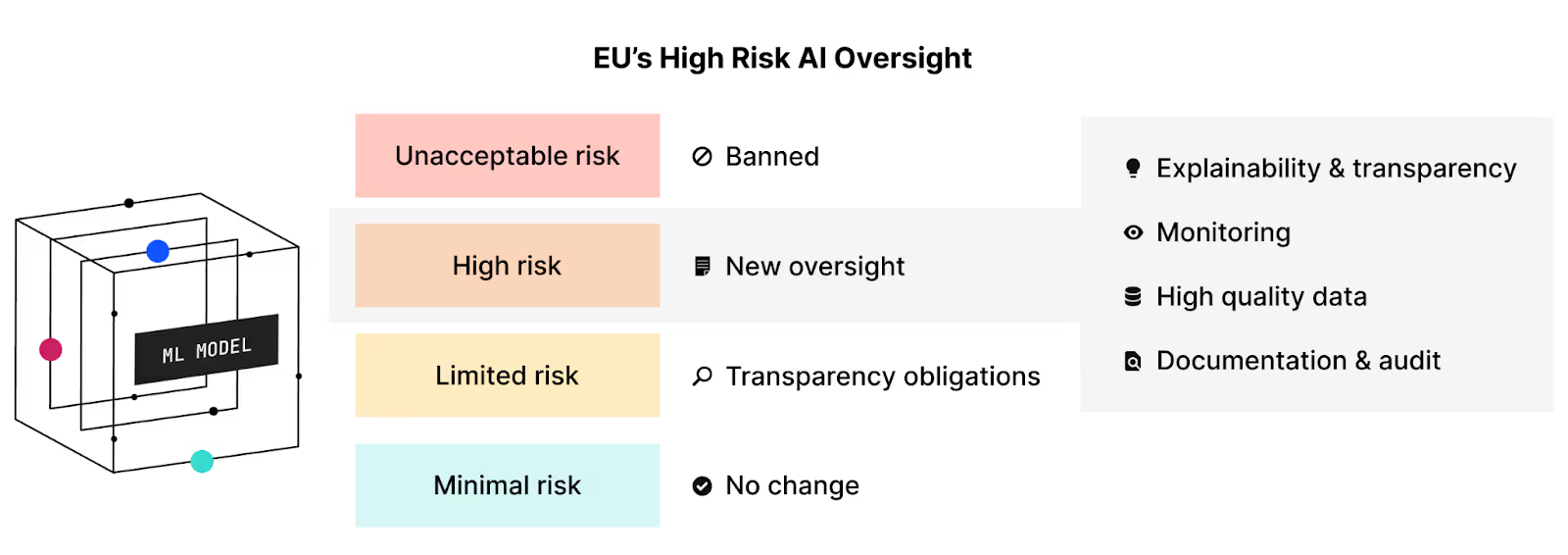2022 was the golden year of AI filled with incredible breakthroughs that were previously considered science fiction.
Here are five trends to look out for in 2023:
1. Monitoring and explainability of AI will be legally required
Like the GDPR, the EU’s AI Act, proposed in 2021, is the first comprehensive guideline of its kind focused on mitigating the harms of AI and ensuring its responsible adoption. In December 2022, the Council of the EU finally approved a compromise version of the text. Along with Parliament’s approval, the AI Act will most likely be adopted in 2023. The act categorizes AI applications using a risk-based approach that mandates transparency and monitoring of high risk AI applications like loan origination. These proposals are the first of many AI regulations that will take effect in coming years.

2. AI ethics will take center stage
AI ethics and model fairness have already been growing areas of concern. However, LLM’s have not only amplified these concerns but also raised new ones. How can artists get royalty for or opt out of generative AI replicating their work? How do we ensure that real-life biases are not perpetuated by ML at such a large scale? With LLMs poised for wide adoption, ethics and AI fairness will become a prominent topic of research and industry discussions as AI experts and practitioners alike struggle to find viable solutions.
Prompted by guidelines like the White House’s AI Bill of Rights, organizations will establish AI councils and model governance teams to put guardrails around the usage of AI. With advances in AI, the concerns around model bias and ethics will also grow. We will see more regulations like the NYC AI Hiring law being mandated by different states in the US.
3. AI & ML adoption will experience hockey stick growth
Every technology begins its adoption curve with a slow initial ramp due to uncertainty around the technology’s viability and value. AI has been in this stage for quite some time. This year however, Large Language Model (LLMs) implementations showcased the immense potential of AI, validating its significant untapped upside. This will spur innovations and market disruptions leading savvy enterprises to accelerate their AI investments, despite ongoing market conditions. As a result, the Compound Annual Growth Rate (CAGR) of the ML market will grow much faster than the predicted 38% in 2023.
4. Usage of NLP and CV models will surpass tabular models
Market research indicates Natural Language Processing (NLP) is growing slower than the overall ML market at a CAGR of 25%, while Computer Vision (CV) is at a CAGR of only 6%. These use cases typically have an easier MLOps lifecycle and clearer business benefit, but have been slowed down as a result of inadequate ML tooling. At Fiddler, we saw a noticeable increase in NLP / CV use cases across industries in late 2022. This is likely a result of ML tooling reaching a maturity threshold that is driving accelerated adoption of these use cases. LLM’s will further accelerate this. In 2023, NLP and CV will finally overtake ML models with tabular use cases.
We will see the rise of MLOps for fine-tuning and deploying foundational AI models like LLMs and Generative AI in the enterprise. Applications will have a far-reaching effect on industries including finance, healthcare, legal, marketing, and entertainment.
5. Generative AI will become multi-modal and multi-language
Even with all the ML breakthroughs of 2022, LLM capabilities have only scratched their potential. The initial use cases focused on single modalities (text-to-text, text-to-image or text-to-silent-video) and largely operated on a single language, predominantly English. In 2023, LLMs will expand into speech, music, and video across languages. Expect to see queries like “Sing me a Taylor Swift song about bitcoin” that generates a song imitating the singer with not just the lyrical style but also the music style.

2023 is poised to be even more ground breaking for AI! Stay tuned and follow us at Fiddler as we track our journey to bring Responsible AI to all ML teams in this transformative era of AI.
